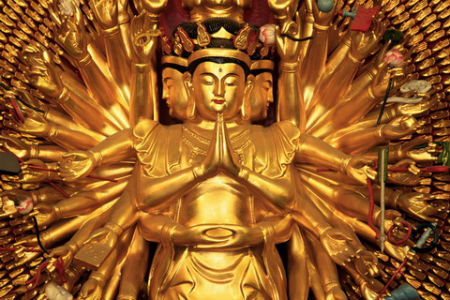The origin of Buddhism in India can be traced back to the middle of the first millennium BC. The Indian society at that time was divided into four castes, or varnas, namely Brahmins, Kshatryas, Vaishyas and Shudras. The Brahmins were the highest caste and enjoyed the highest privileges; the Shudras were the lowest. Although the latter formed the bulk of the population, they were considered the servants of the other three varnas. The system of varnas was protected by Brahmanism and the Law of Manu (the oldest law in India). As a social doctrine, Buddhism opposed the varna system. Buddhism inherited and developed from other religions and popular Indian ancient philosophies (such as the doctrine of Brahmanism, Samkhya, Yoga, Naya, Vaisesika, Mukti, and worship)
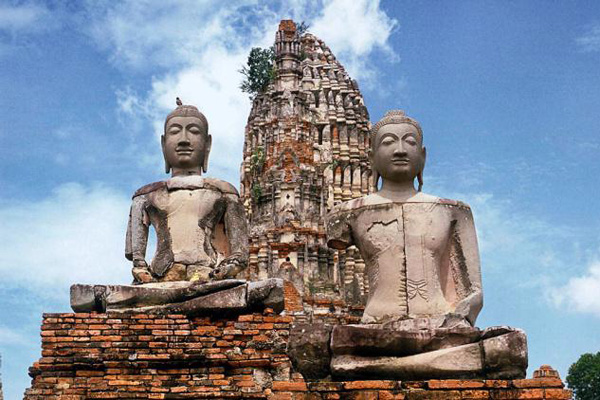
History of Buddhism
The founder of Buddhism was Prince Siddhartha Gautama, who was born around 560 BC into a Sakya clan. He was the son of Shuddhodana, the King of Kapilavastu – a small principality located in present-day Nepal. Talking a bit about Buddhism in Nepal, although this is a place where the founder of Buddhism was given birth, this religion had always been considered second. It was back in 2015 on my very first go Nepal tours, I noticed that only 9% of the Nepali population followed Buddhism. Continue with the story of Siddhartha Gautama, he abandoned the luxurious life of the palace to lead a religious life. After a time, he claimed to have reached the truth about the nature of existence and the root of misery and human suffering; with this understanding, he was able to reveal the path to salvation. From that time on, he was called the Enlightened One, a saint of the Sakyas, or Sakyamuni. Sakyamuni Buddha traveled and expounded his teachings which were later formulated into the doctrines of Buddhism.
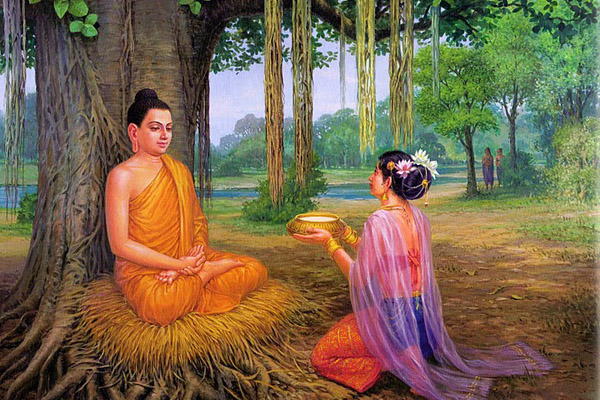
The Teachings of Buddhism
The Buddha's teachings are recorded in a threefold collection of authoritative texts referred to as the Tripitaka, or the three baskets of the Buddhist Canon: the first, the Sutra Pitaka, consists of the Buddha's discourses; the second, the Vinaya Pitaka, records rules to guide the practice of the commandments; and the third, the Abhidhamma, is a collection of texts explaining the Sutra Pitaka and Vinaya Pitaka. The three baskets of the Buddhist Canon were formed after Buddha entered Nirvana. Not until the Fourth Great Council in the second century AD did the Tripitaka get its complete form. Originally, the Tripitaka was written in Pali and Sanskrit, two important languages in ancient India. Later, Buddha's teachings were translated into many other languages and disseminated worldwide.
Buddha's teachings gave a thorough explanation of the nature of the world and the destiny of humankind. His teachings can be formulated around some key issues and focused as answers to questions such as: How did the material world of people and things come about? What is the role of humans in this world? What happens after death, and what is the relationship between the living and the dead? These issues and questions are at the heart of Buddha's main teachings, which make use of concepts such as Dharma (law, truth); Hrdeya (heart, mind); Anitya (impermanence); Hetupratyaya (cause); emptiness; and Anatman (no-ego). One of the central concepts is the notion of Samsara, the cycle of rebirth and the transmigration of souls, linked to Karmavipaka (retribution for karma) and the twelve nidanas, or links in the chain of existence. The Four Noble Truths summarize these insights and reveal the path to Nirvana, the realization of the Buddha's nature.
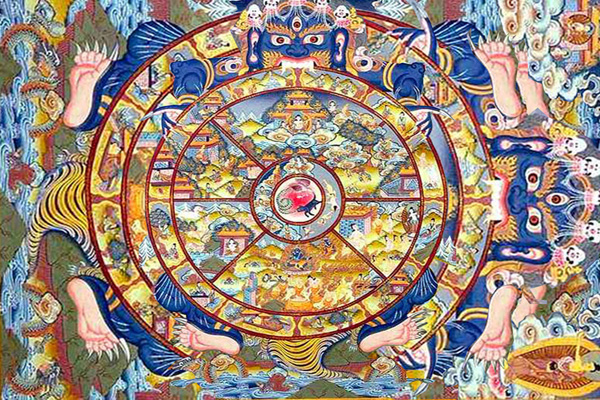
It is the Buddhist belief that the world is always changing, without beginning or end, the result of self cause-effect. Things and phenomena are unreal and illusory. According to Buddha's teachings, no Supreme Being created humankind, and death is not the end of everything. An individual man is just one dharma in the world of dharmas, a combination of Pancaskandha (the Five Aggregates). Thus, the ego is also unreal (Anatman). People are miserable because of ten fetters (Samyojana), in which the three poisons of greed, lust, and ignorance are caused by Avidya. One's present life is the product of a previous life, and according to "three-generation cause and effect," it fashions one's next life. If one is able to get rid of worldly attachments, to get rid of greed, lust and ignorance, and reach enlightenment, one is delivered and is then able to enter Nirvana.
Buddhism has formulated a set of rules to guide disciples (lay people and monastics) in cultivating and following the Buddha's truth. There are detailed regulations for right action and the full control of lust and evil deeds to achieve deliverance. The core of Buddhist Law is to follow the Five Commandments (against killing, stealing, adultery, lying and use of intoxicants); to perform the Ten Good Virtues in action, speech and thought; to follow the Noble Eightfold Path (right speech, action, effort, livelihood, mindfulness, concentration, view and thought); to follow the six points of unity in monastic life; and to observe the four immeasurable states of mind (boundless kindness; boundless pity; boundless joy; and limitless indifference).
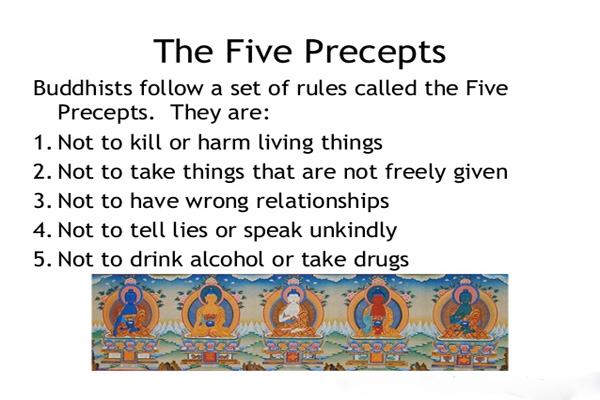
The Rituals of Buddhism
Initially, Buddhist rituals were simple, focusing mainly on worshipping Buddha and spreading the doctrine. Later, more complex rituals were added, especially when Buddhism was divided into two main branches (Theravada and Mahayana) and absorbed some of the cultural and religious features of the localities where it became established, resulting in regional variations in rituals and worship. Notably, it can be said that Vietnamese Buddhism differs from that of another mainland Southeast Asian Buddhist countries in that it was both Theravadinistic and Mahayanistic from an early stage, and has been heavily influenced by Confucianism and Taoism."
From the earliest times, Buddhism was opposed to the system of varnas and the traditions which gave privileged status to the Brahmins and imposed complex and costly rituals on the people. Buddha's teachings emphasized the human role of self-deliverance and individual people's ability to be in full control of their destiny. Equality among people and simple rituals were two of the attractive features of Buddhism and accordingly, it became popular with the general public, particularly the poor. Only two centuries after its birth, in the third century BC, Buddhism had spread across India. Buddhism in India developed vigorously as a national religion especially under the rule of Emperor Asoka (second century BC) and later under King Kanishka (second century AD). However, from the eighth century onwards, it grew weaker owing to reforms in Brahmanism and the armed penetration of North India by a new religion, Islam.
However, at the same time, Buddhism expanded vigorously into Asian countries. An early form now referred to as Theravada Buddhism was introduced to Southern countries like Sri Lanka, Myanmar, Thailand, Cambodia, and Laos. Another important branch, Mahayana Buddhism, developed and spread through China, Japan, Korea, and Vietnam. The spread of Buddhism to these various countries is marked by one common feature: Buddhism spread peacefully, and it co¬existed with other religious practices in the localities where it arrived. In a sense, it also played a significant and important role in consolidating the way of life, customs and traditions of these countries, and served to build up and protect independence in many instances.
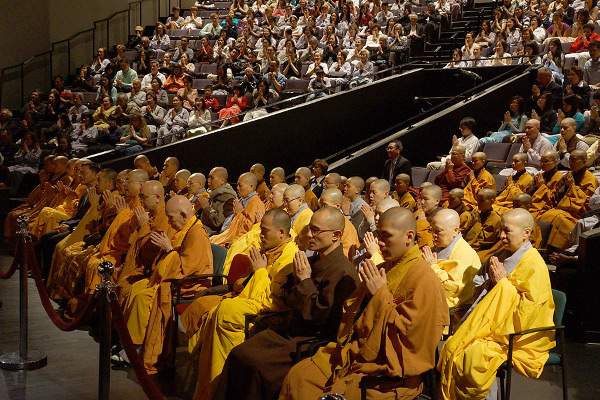
In the present era, Buddhism is acknowledged to be one of the great world religions with more than 325 million sincere disciples who follow the Triratna (Buddha, Dharma and Sangha), among the more than one billion people who are under Buddhist influences in terms of culture, ethics, way of thinking and way of life. Asian countries with significant Buddhist populations include China, 74.23 million; Japan, 48.17 million; Thailand, 57.57 million; Sri Lanka, 14 million; Cambodia, 11 million; Vietnam, 10.5 million; Taiwan, 10.5 million; and Laos, 3.5 million. By continent, the numbers of Buddhists worldwide are Asia, 322 million; Europe, 1.20 million; America, 2 million; Australia, 0.5 million. These figures indicate that Buddhism remains mostly an Asian religion; but in recent decades, it has spread into other countries, including America and Europe.

